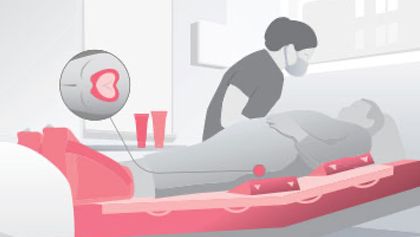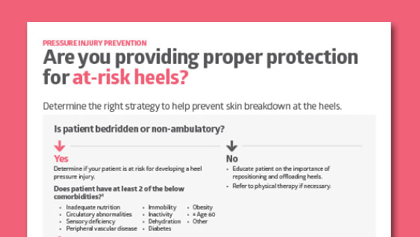4 ways to raise the Braden Scale to lower pressure injuries
Taking a closer look at Braden subscales and other tips to improve outcomes.

You have a variety of skin assessment tools to help prevent and treat pressure injuries. One of these is the Braden Scale for Predicting Pressure Sore Risk. Developed by Barbara Braden and Nancy Bergstrom in 1984, and now used in more than two dozen countries, the Braden Scale helps improve patient care and protect at-risk skin in a number of important ways.
The Braden Scale helps:
• Keep staff accountable to a well-known standard of measurement
• Provide quantitative pressure injury risk data
• Identify at-risk patients who may be more prone to pressure injuries
• Reduce the incidences of pressure injuries
• Determine the right care plan based on patients’ Braden subscales
• Decrease costs by avoiding further skin damage

Despite these many benefits, the power of the Braden Scale has waned over the years, now often considered “a check box instead of a lesson,” says Katie James, BA, RN, CWCN, Medline Clinical Education Specialist.
“Less experienced nurses are completing the Braden Scale and not utilizing critical thinking skills along with it,” notes Medline Clinical Education Specialist Kim Kehoe BSN, RN, CWOCN, DAPWCA.
In post-acute settings, it’s even more challenging because caregivers use the Braden Scale so infrequently that it’s not second nature yet. “Out of sight out of mind,” says Kaila Martin, Medline Sales Program Manager.
“Less experienced nurses are completing the Braden Scale and not utilizing critical thinking skills along with it.”

Kim Kehoe
BSN, RN, CWOCN, DAPWCA, Medline Clinical Education Specialist
It’s time to think more critically about the Braden Scale, its subscales and how it can help caregivers better understand and plan interventions to prevent pressure injuries and other skin breakdown. Here are 4 things you can do to elevate the value of your Braden Scale assessments, including a downloadable guide to help empower caregivers to use the Braden Scale more effectively.
1
Use the subscales
Most caregivers understand the basics: The Braden Scale can result in a score from 6 to 23. The lower the score, the greater the risk for developing a pressure injury. But what’s not highlighted often enough is this: The total score is the sum of six subscores from six subscales, and it’s often more meaningful to look at the subscale scores. The question is, Kehoe says, “Are caregivers connecting the dots and implementing a care plan based on the subscale scores?”
When it comes to fully benefitting from the Braden Scale, it helps to focus on those six subscales. The subscales measure distinct factors that can each contribute to pressure injury development: sensory perception, moisture, activity, mobility, nutrition, and friction and shear. Five of the subscales can have individual scores from 1 to 4; friction and shear is scored with 1 to 3.
These subscores have their own stories to tell.
If any of those subscores are 1, it may signal the patient is at high risk for wounds. In fact, in 2012, Barbara Braden herself recommended that nurses use each subscore as “an initial appraisal of a patient’s specific problems and functional deficits.”1
During a recent chart review, Kehoe noticed that a nursing staff member had entered “dependent on ventilator” in the patient’s electronic health record. Yet the patient’s total Braden score was documented as a 20.
“Pay attention to each subscore, and down the road, you’ll help prevent a pressure injury that may require more effort.”

Kaila Martin
Medline Sales Program Manager
“That nurse couldn’t possibly have been looking at the subscales,” Kehoe says. “Not that a person on a ventilator couldn’t be alert, but likely not. Chances are they were bedfast, so the mobility subscore was probably a 2 or 3, maybe even a 1.” In a case like this, the low mobility score should be taken into account—on its own—when planning for prevention. Was the patient set up with the proper repositioning and offloading tools? Would the patient need more frequent turning?
Using this valuable subscale information can help nurses do the right thing when it comes to preventive measures and treatment. “Pay attention to each subscore, and down the road, you’ll help prevent a pressure injury that may require more effort,” Martin says.
Download and share this at-a-glance guide to help caregivers determine the right plan of care when a Braden subscore is low.
2
Allow for more clinical judgment
Katie James notes, “The average patient today comes in with six comorbidities.” Some of these factors, whether chronic conditions or short-term, aren’t measured by the Braden Scale and therefore not always added into the risk assessment for pressure injuries. This is where good nursing judgment is key.
For example, the presence of an existing pressure injury or history of past pressure injuries are highly relevant in determining a patient’s risk for future wounds. Equally important are factors such as advanced age, low diastolic blood pressure, increased body temperature, low protein intake, recent weight loss, and use of chemotherapy or steroids.2 But the Braden Scale doesn’t account for any of those conditions.
It’s time to think more critically about the Braden Scale, its subscales and how it can help caregivers better understand and prevent pressure injuries.
It’s important for administrators to understand the inherent nuances involved in risk assessments. Be sure to consider where your care team is in their knowledge and experience. Then help empower and encourage caregivers to apply what they know to help determine the right next steps for each individual patient or resident. At the same time, think about ways to further build their practice with the Braden Scale.
3
Educate and engage caregivers to support the Braden Scale
Staff education is key to helping care for patients and reduce the number of pressure injuries, but frontline nurses aren’t typically taught the Braden Scale in nursing school. That’s why it’s so helpful to provide learning opportunities for caregivers to help support their understanding of the Braden Scale and its subscales.
Steal these ideas to help reinforce best practices:
- Run through real patient case studies using the Braden Scale.
- Provide lunch-and-learn time for continuing education that fits in with busy nursing schedules.
- Share at-a-glance materials that offer proven interventions based on Braden Scale subscores. Pairing subscores with action means caregivers can better use the Braden Scale as an effective tool to fight pressure injury formation.
- Keep an ongoing bulletin board of patient Braden scores and subscores to spark conversation at the bedside.
- Advocate for a system of products that meets the needs of each subscore that indicates risk of pressure injury formation.
- Register for targeted education that covers the Braden Scale and other pressure injury topics.
4
Customize protocols
Determining a Braden Scale score and factoring in nursing judgment is just the beginning. Using those numbers to inform care planning to prevent pressure injuries is the most important step. You can save time by standardizing prevention protocols, including focusing more attention on total Braden Scale scores and each subscore.
Each health care facility is unique in terms of staffing, as well as wound care specialists and products used. So it helps to work with leadership and a trusted supply vendor who understands the complexities of wound assessment to develop specific protocols that fit your facility.
Key takeaway
The Braden Scale is a staple of wound assessment for good reason. It offers many benefits when used to its full potential. Knowing how to make the most of it can help frontline nurses make the right decisions on preventing and treating pressure injuries. Empower caregivers with education on better using the Braden Scale and its subscales. Encourage them to use their critical judgment to take into account all the factors and medical history of an individual, and be sure to customize protocols depending on what works best for your care setting.
Note: To utilize the Braden Scale in your health care facility, visit www.bradenscale.com and complete the Permission Request form.
References:
- The Braden Scale for Predicting Pressure Sore Risk:. . . : Advances in Skin & Wound Care. (n.d.). LWW. https://journals.lww.com/aswcjournal/fulltext/2012/02000/The_Braden_Scale_for_Predicting+_Pressure_Sore.4.aspx
- Warner-Maron, I., PhD, RN-BC, CWCN, CALA, NHA, FCPP. (2019, November). Update on the Braden Scale. HMP Global Learning Network. https://www.hmpgloballearningnetwork.com/site/altc/content/update-braden-scale




